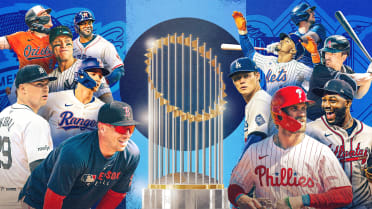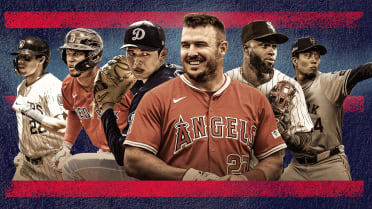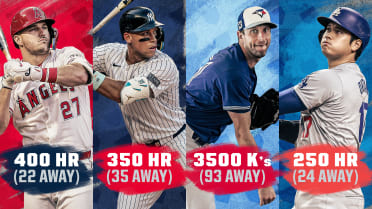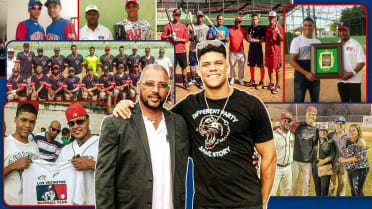Many players may claim to love baseball, be devoted to baseball, to wake up every day living and breathing baseball. But compared to Orestes “Minnie” Miñoso -- the sport’s only seven-decade player, who played anywhere and everywhere, who became the first Black player on the White Sox and who helped pave the way for generations of Latino players -- they’re all dilettantes.
With a crouched stance, strong swing and an abundance of hustle, Miñoso put together a career that makes many believe he is the best player not in the Hall of Fame.
He had 1,963 hits in the Majors, and over 3,000 if you count the many leagues he played in. He held a since-broken record of 192 career HBP and led the American League in steals three times. He smashed 186 home runs, won three Gold Gloves and ran down countless hits in the outfield. He was a nine-time All-Star -- a number that grows to 11 if you include his Negro League All-Star Games. Mickey Mantle’s nickname, The Commerce Comet, was a play on Miñoso’s nickname, The Cuban Comet. Orlando Cepeda has called him “the Jackie Robinson of Latin America."
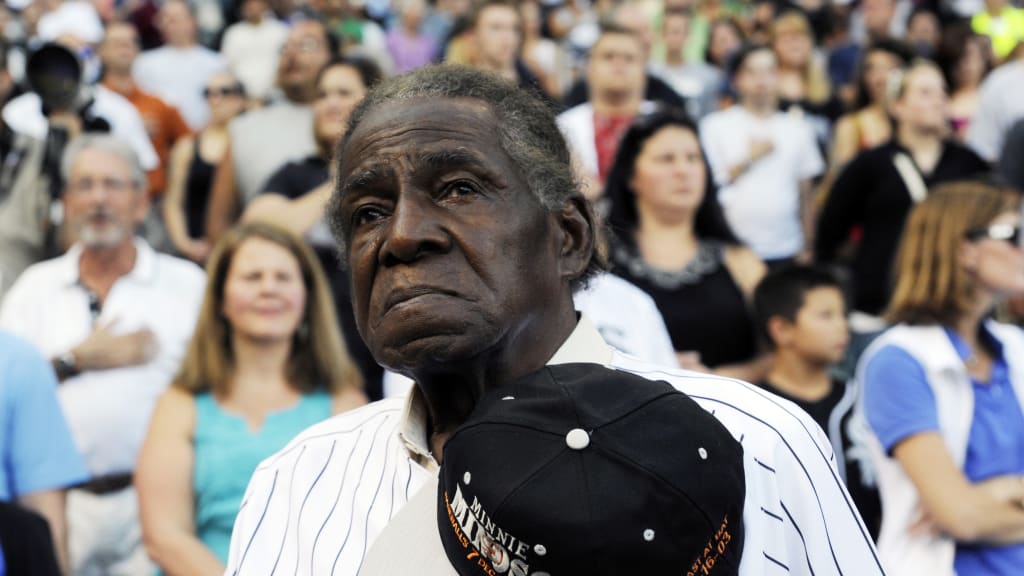
Every story about him includes fond memories of his attitude, his kindness, his friendliness. There are even tales that sound more like urban legends, where fans would spot Miñoso’s Cadillac and his “MINOSO” personalized license plate and wave to him. From there, Miñoso would do anything for a fan -- including chasing you down on the highway to say hello and hand out some caps and take some photos.
You could fill books with tales of Miñoso, who passed away in 2015, so we’ll do our best to give a brief overview of his amazing, unlikely and never-to-be-duplicated seven-decade career.
1940s
Much of Miñoso's childhood was spent living and working on a ranch in El Perico, Cuba. But when he was 16 years old and living with family friends, he became restless and ready for new challenges. Miñoso wanted to get to Havana and play baseball for some of the best teams in the country. He felt guilty about leaving the family, which he helped support at the farm, so he conceived a plan.
He asked his friend, Umberto, who was the mailman and a fellow baseball player, to do him a favor. As Minnie wrote in his autobiography, “Just Call Me Minnie,” Umberto forged a letter addressed to “Orestes Miñoso” from a team owner. With the letter mailed -- and stamped -- from Havana, it arrived a few days later.
“Suddenly someone came shouting, ‘Orestes! Orestes! There’s a letter here for you from Havana!’ Of course I played dumb. I pretended to be surprised. I opened the letter and read it. I looked shocked. ‘They’re really crazy. … They want me to play baseball in Havana. I can’t do that. There’s too much work for me to do here.’ My father’s friend took the letter from me and read it. ‘What do you mean? What are you waiting for, Orestes?’ he said. ‘You better go right now.’”
When he arrived in Havana, he arranged a tryout with one of the bigger semi-pro teams, the Ambrosia Candy Factory. When he showed up, they asked him what position he played. Miñoso had played every position, so he simply looked around the field, saw the player who seemed to have the least talent and announced that he was a third baseman. That’s how Miñoso got his first position.
He went on to star for the Marianao team in the Cuban baseball league, but his path to the Major Leagues was slim. Baseball was still not integrated, and there were few Latino players in the league. So, when members of the outlaw Mexican League offered Miñoso $30,000 to play for two seasons -- an opportunity that would have barred him from the Majors in the future -- it took a lot of courage to turn them down.
With only $50 in his pocket, Miñoso said no. “My $50 is like two pennies compared with what you just showed me, but money isn’t everything to me. I’m going to America one day," Miñoso said.
Once again, the faith he had in himself paid off. The New York Cubans of the Negro Leagues soon signed Miñoso, who made his debut in 1946. After struggling in his first season, Miñoso led the Cubans to the Negro Leagues World Series title in 1947, hitting .346. The next season, he did even better, hitting .350 and displaying more power.
That caught the eye of the Harlem Globetrotters’ Abe Saperstein, who recommended him to the Indians front office. They signed Miñoso and he made it to the Major Leagues in 1949.
1950s
Miñoso's career would change thanks to the scouting eye of manager Paul Richards, who brought him to Chicago as part of a three-team trade in 1951.
Thanks to his hustle and talent, he became an instant star who epitomized the "Go-Go" White Sox. Fans flocked to see White Sox games like never before. (In future years, attendance would dip following him being traded, and would spike when he was re-acquired.)
It was not all easy. He was the first Black player in Chicago. Opposing players would hurl slurs at Miñoso. He was told he couldn’t play in an exhibition game in New Orleans, and manager Paul Richards stepped forward to say that if Miñoso didn’t play, the whole team wouldn’t play.
While many of Miñoso’s HBPs could have been because he willingly crowded the plate, that wasn’t always the case. Miñoso told ESPN’s Christina Kahrl about a time where he was hit in Philadelphia and Richards wanted to pull him from the game:
“I said, ‘Paul, I'm not going to come out.’ He said, ‘But you're black and blue!’ I said, ‘Well, I'm Black. I don't know about blue, and I'm not going to come out. Because if I come out now, it's going to spread around the whole league, and every time, in every city, they're going to try to intimidate me.’"
Fortunately, back home in Cuba, where he played every winter, he was not only a superstar, but a symbol of hope for the island’s best.
Tony Pérez, the future Reds Hall of Famer, looked up to Miñoso as a young boy growing up in Cuba, where he would listen to his games on the radio every night.
“Minnie was the best player at that time who was playing in Cuba,” Pérez told MLB.com. "Everybody knew who Minnie Miñoso was. Even the kids knew about Minnie. The other players -- they're good, too -- but Minnie was the guy who everybody looked up to when they listened to games from the Major Leagues.
“I just told my father that I want to be like Minnie Miñoso,” Pérez added. “Every night, we’d sit around on the porch and we're talking about the game and listening to the game, I would say, ‘I gotta be like Minnie Miñoso.’”
Pérez first met Minnie when he was playing at the Havana Sugar Kings academy as a teenager. At the time, Miñoso was still playing winter ball with Marianao -- which also owned the Sugar Kings. So, Pérez was able to watch their games from the dugout.
“And then I saw Minnie there in the clubhouse and watched him play from the dugout. That was something impressive for me. I mean, I’ll never forget it,” Pérez said. “I thank God every day that I was allowed to do that.”
1960s
After being traded by the White Sox in 1957, they brought him back before the 1960 season. Though he wasn’t with the team in 1959 when they went to the World Series, he was so beloved that he was presented with an AL Championship ring for a team he wasn’t even on. How many other players can claim that?
Sadly, 1960 would be his last great season -- at least in the Major Leagues. He hit over .300 -- again. He led the American League in hits -- and led the Majors in hit by pitches for the ninth time. He went to his ninth and final All-Star Game and won his last Gold Glove.
Miñoso bounced around then, playing for the Cardinals, Senators, and yes, White Sox one more time (for how could you keep Mr. White Sox away?) before retiring in 1964.
Instead of fully retiring from the game or becoming a coach, Miñoso went to the Mexican Leagues and played with the Charros de Jalisco. He hammered the ball there -- hitting .348 in ‘66 -- and later became a player and manager for their farm club in Orizaba and then in Puerto Vallarta. After hitting .301 with Puerto Vallarta in 1969, many might have thought that Minnie would have hung them up. After all, he was 43 years old.
But Minnie was just getting started.
1970s
After joining Algodoneros de Union Laguna and continuing to play with teams in Leon and the small mining town of Cananea, the Miñosos did something that only the Griffeys have done before: hit back-to-back home runs. In either 1974 or ‘75 -- sadly, there are no stats available -- Minnie’s son, Orestes Jr. played on the same Puerto Vallarta team that his father did. And this time, the home runs clinched a postseason berth.
As Miñoso wrote in his book, Puerto Vallarta was down by one run in the seventh inning when Orestes Jr. stepped to the plate with two on. He hammered a home run.
“As my son crossed the plate, I shook his hand,” Miñoso wrote. “Then I stepped up and hit the ball out of the park in exactly the same spot.”
And then, in 1976, Miñoso made it back onto the White Sox roster when Bill Veeck retook control of the team. He suited up on Sept. 11 for his first big league action since 1964. He went 0-for-3. Undeterred, he was in the lineup again the next day. Sure enough, in the bottom of the second inning, Miñoso -- then 50 years old and wearing the famous collared jerseys -- lined a single to left field off Sid Monge. Miñoso was the first to ever record a hit in four different decades.
1980s
At 54, but with no less confidence than when he first reached the Majors, Minnie again made it onto the lineup card in 1980.
He received a pinch-hitting appearance against Frank Tanana on Oct. 4, and he popped out in foul territory. He got another chance the next day and grounded out against Dave Schuler. While he didn't record a hit, he did become the only Major Leaguer to play in five different decades.
1990s
And still, Miñoso wasn’t done. A White Sox team employee during the ‘80s, he was a constant presence at the stadium and in the community. So, with Comiskey Park coming to a close at the end of the 1990 season -- and with the White Sox already out of a playoff spot, team owner Jerry Reinsdorf wanted to help Minnie become a six-decade player.
Only problem, before the game began, Commissioner Fay Vincent intervened. It was off.
Again, he almost got his opportunity in 1993, but this time the players objected.
Miñoso wanted to do it, having said, “This is not a clown thing. I love the game. I gave all my life to it." So, it was up to Mike Veeck, owner of the independent St. Paul Saints and the inventor of some of the most original baseball promotions, to intervene.
Veeck made it clear that this wasn't just a promotion to get fans into the gates and that a baseball player, especially one like Miñoso, would not do anything to embarrass himself.
“I don't think of it as a promotion, I think that's an appearance of talent,” Veeck told MLB.com. “That's how I view it -- it’s an opportunity for these younger fans, and for fans who enjoy them to see this remarkable human who all these years later could still swing the bat, who still hustled out to first base.”
So, Miñoso, now 67, stepped in to the box to face 19-year-old rookie hurler Yoshi Seo. Miñoso smacked a hard grounder back up the middle that, unfortunately for everyone in attendance, Seo snagged.
“I really thought he was gonna pull it off and single sharply -- as we like to say in the trades,” Veeck remembered. “It was a behind-the-back pick. But the most telling thing for me was how he hustled down to first and how he related to the Saints players. You know, there's a beauty in baseball that supersedes language barriers and things like that.”
2000s
Ten years later, when Miñoso was 77, he got up again for the Saints.
“Miñoso was no fool, and he understood what he represented -- not just to baseball fans who had seen him play but to Cubanos who came up,” Veeck said. “This was a remarkable feat. Forget baseball, this comes down to being sharp enough at his age to compete with kids a third his age. And so he was thrilled.”
Miñoso dug in at the plate and, wearing his old New York Cubans uniform, stared down former big leaguer Tim Byrdak. He drew a walk.
There are some who think that Miñoso’s play in all these later decades harmed his chance at the Hall of Fame, that he made a mockery of his career and the game by continuing to play baseball. Veeck is hurt by this accusation, and he knows his dad would have been hurt by it, too.
But these events weren't a circus sideshow for Minnie. He played before baseball was integrated and played his final game when you could stream any game you wanted on the internet. He played with Luis Tiant Sr. on the New York Cubans and got his final at-bat with the White Sox two years before Luis Tiant Jr. hung them up.
"I don't think I could do anything else," Miñoso told the Chicago Tribune in 2003. "Baseball is in my blood."
For even more proof -- as if seven decades in the game weren’t enough -- Veeck shared a story from 1990 when Comiskey was about to be torn down. He had arrived the night before to “steal the souls from Comiskey” and escort them across the street to the new stadium that stands there today. While on a tour of the new digs, he looked into right field:
“And there was Miñoso, running full steam into the right-field wall, bouncing off the pads," Veeck said. "After we finished the next day, I said, 'Did you break it in enough?' He goes, ‘Oh, yes. Yes, indeed, they will know Miñoso's been there.’”
Michael Clair writes for MLB.com. He spends a lot of time thinking about walk-up music and believes stirrup socks are an integral part of every formal outfit.

